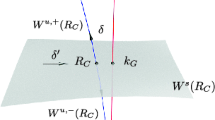Abstract
We prove that for a sequence of nested sets \(\{U_n\}\) with \(\Lambda = \cap _n U_n\) a measure zero set, the localized escape rate converges to the extremal index of \(\Lambda \), provided that the dynamical system is \(\phi \)-mixing at polynomial speed. We also establish the general equivalence between the local escape rate for entry times and the local escape rate for returns. Examples include a dichotomy for periodic and non-periodic points, Cantor sets on the interval, and submanifolds of Anosov diffeomorphisms on surfaces.
Similar content being viewed by others
Notes
Since in most situations, the rate of convergence for the entry times statistics \(|{\mathbb {P}}(\tau _U>\frac{t}{\mu (U)}) -e^{-\alpha t}|\) is independent of t (see for example [1, 15]; also see [13] where the error is a linear multiple of t); however, the localized escape rate problem requires one to obtain an error that is exponentially small in t, with rate higher than \(\alpha _1\).
We note that for piecewise expanding maps on higher dimensions, one could potentially use the functional space constructed by Saussol [20] which is an analog of the BV space in one dimension.
The existence of stochastic processes that are polynomially \(\phi \)-mixing is proven in [17, Theorem 2]. However, we do not know if there are any dynamical system examples without spectral gap (over certain Banach spaces).
References
Abadi, M.: Hitting, returning and the short correlation function. Bull. Braz. Math. Soc. 37(4), 1–17 (2006)
Bruin, H., Demers, M., Todd, M.: Hitting and escaping statistics: mixing, targets and holes. Adv. Math. 328, 1263–1298 (2018)
Carney, M., Holland, M., Nicol, M.: Extremes and extremal indices for level set observables on hyperbolic systems. Nonlinearity 34(2), 1136–1167 (2021)
Demers, M., Todd, M.: Asymptotic escape rates and limiting distributions for multimodal maps. Preprint. Available at arXiv.org/abs/1905.05457
Demers, M., Young, L.-S.: Escape rates and conditionally invariant measures. Nonlinearity 19(2), 377–397 (2006)
Dreher, F., Kesseböhmer, M.: Escape rates for special flows and their higher order asymptotics. Ergod. Theory Dynam. Syst. 39(6), 1501–1530 (2019)
Faranda, D., Moreira Freitas, A.C., Milhazes Freitas, J., Holland, M., Kuna, T., Lucarini, V., Nicol, M., Todd, M., Vaienti, S.: Extremes and Recurrence in Dynamical Systems. Wiley, New York (2016)
Ferguson, A., Pollicott, M.: Escape rates for Gibbs measures. Ergod. Theory Dynam. Syst. 32(3), 961–988 (2012)
Freitas, A.C.M., Freitas, J.M., Todd, M.: The compound Poisson limit ruling periodic extreme behaviour of non-uniformly hyperbolic dynamics. Comm. Math. Phys. 321, 483–527 (2013)
Freitas, A.C.M., Freitas, J.M., Magalhães, M.: Convergence of marked point processes of excesses for dynamical systems. J. Eur. Math. Sci. 20, 2131–2179 (2018)
Freitas, A.C.M., Freitas, J.M., Rodrigues, F.B., Soares, J.V.: Rare events for Cantor target sets. Preprint. Available at arXiv.org/abs/1903.07200
Haydn, N., Vaienti, S.: The distribution of return times near periodic orbits. Probab. Theory Related Fields 144, 517–542 (2009)
Haydn, N., Vaienti, S.: Limiting entry times distribution for arbitrary null sets. Comm. Math. Phys. 378(1), 149–184 (2020)
Haydn, N., Yang, F.: Local Escape Rates for \(\varphi \)-mixing Dynamical Systems. To appear on Ergodic Theory Dynam. Systems. Preprint available at arXiv.org/abs/1806.07148
Hirata, M., Saussol, B., Vaienti, S.: Statistics of return times: a general framework and new applications. Comm. Math. Phys. 206(1), 33–55 (1999)
Keller, G., Liverani, C.: Rare events, escape rates and quasistationarity: some exact formulae. J. Stat. Phys. 135, 519–534 (2009)
Kesten, H., O’Brien, G.L.: Examples of mixing sequences. Duke Math. J. 43(2), 405–415 (1976)
Melbourne, I., Nicol, M.: Almost sure invariance principle for nonuniformly hyperbolic systems. Commun. Math. Phys. 260, 131–146 (2005)
Pollicott, M., Urbański, M.: Open conformal systems and perturbations of transfer operators. Lecture Notes in Mathematics, vol. 2206. Springer, Cham (2017)
Saussol, B.: Absolutely continuous invariant measures for multidimensional expanding maps. Israel J. Math. 116, 223–248 (2000)
Yang, F.: Rare event process and entry times distribution for arbitrary null sets on compact manifolds. Ann. Inst. Henri Poincaré, Probab. Stat. 57(2), 1103–1135 (2021)
Young, L.-S.: Statistical properties of dynamical systems with some hyperbolicity. Ann. Math. 7, 585–650 (1998)
Young, L.-S.: Recurrence time and rate of mixing. Israel J. Math. 110, 153–188 (1999)
Author information
Authors and Affiliations
Corresponding author
Additional information
Communicated by Dmitry Dolgopyat.
Publisher's Note
Springer Nature remains neutral with regard to jurisdictional claims in published maps and institutional affiliations.
Rights and permissions
About this article
Cite this article
Davis, C., Haydn, N. & Yang, F. Escape Rate and Conditional Escape Rate From a Probabilistic Point of View. Ann. Henri Poincaré 22, 2195–2225 (2021). https://doi.org/10.1007/s00023-021-01070-z
Received:
Accepted:
Published:
Issue Date:
DOI: https://doi.org/10.1007/s00023-021-01070-z




